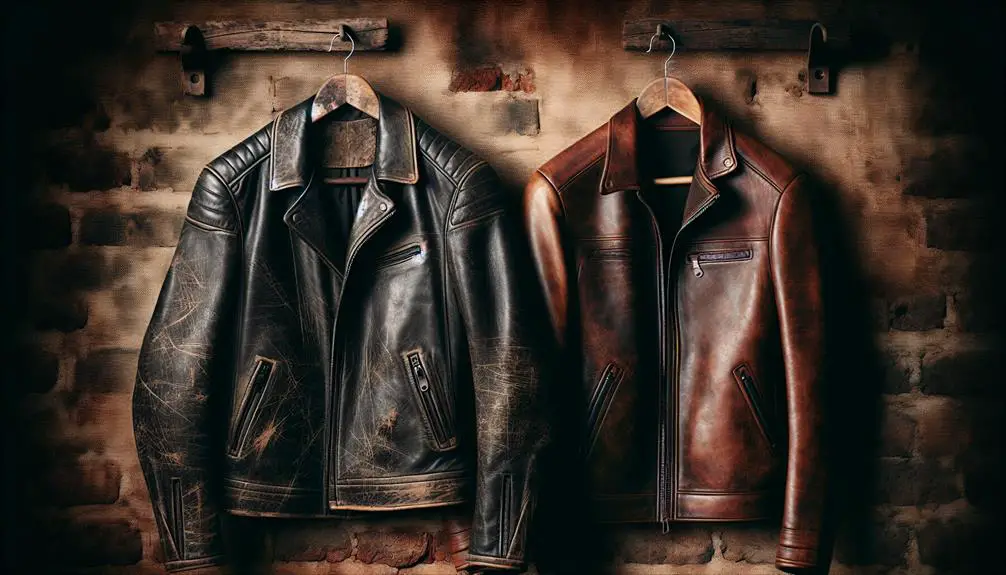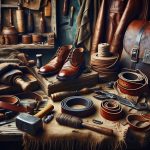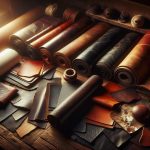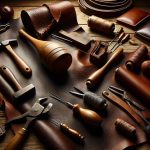Absolutely, leather can last a really long time, especially if it's quality stuff like full-grain leather. This kind of leather not only toughs it out through years of use but actually gets better with age. It develops what's called a patina, which adds character and makes it look even cooler over time. Of course, how long it lasts depends a lot on how well you take care of it. Regular conditioning and proper storage are key to keeping leather in tip-top shape. There's quite a bit more to explore about how different types of leather and care methods affect its longevity.
Table of Contents
Key Takeaways
- Full-grain leather is highly durable and can last decades with proper care.
- Regular conditioning helps maintain leather's suppleness and prevents cracking.
- Quality of leather, like full-grain versus bonded, greatly affects its longevity.
- Leather should be stored in cool, dry conditions to prevent damage.
- Leather's durability improves with age, developing a unique patina that adds value.
Understanding Leather Durability
When it comes to choosing durable materials, leather, especially full-grain leather, really stands out for its strength and longevity. I've learned that the quality of leather significantly impacts its durability. Full-grain leather, being the top-notch type, holds up remarkably well over time. This isn't just because it's tough; it's also about how it ages. Unlike other materials that wear out, full-grain leather develops a character, known as a patina, which actually enhances its look with age.
The reason I always lean towards leather products made from full-grain leather isn't just a matter of style. It's about investing in something that lasts. We're talking decades here, maybe even a lifetime, if you care for it properly. It's the kind of material that doesn't just endure; it improves, becoming more flexible and appealing as it ages.
Types of Leather Explained
Let's dive into the different types of leather so you can better understand what you're buying. Knowing the types of leather can massively impact your purchasing decisions and satisfaction with leather goods.
Here's a quick breakdown:
- Full-grain leather: This is the cream of the crop when it comes to leather. It's the most durable and retains the natural markings of the animal's skin. Because it isn't sanded or buffed, it develops a unique patina over time that many folks adore.
- Top-grain leather: Next in line, top-grain leather is also quite durable but has been sanded down slightly to remove imperfections. It's smoother and more uniform in appearance, making it popular for things like jackets and high-end bags.
- Genuine leather: Don't let the name fool you; genuine leather is actually lower on the quality scale. It's made from leftover leather scraps that are reconstituted. It's affordable but doesn't hold up as well as the top two.
- Bonded leather: At the bottom, you've got bonded leather. Made from shredded leather scraps and polyurethane, it's less durable and more prone to damage.
Understanding these differences helps you make smarter choices and ensures the longevity and enjoyment of your leather items.
Factors Affecting Leather Longevity
The longevity of leather heavily depends on its quality, how we care for it, and where it's stored. Let's break it down a bit. Starting with quality, not all leather is created equal. Full-grain leather, for example, is top-notch. It's the most durable type and can stick around for decades if you treat it right. This kind is often smooth and just gets better with age.
Now, not to dive too deep into specific care routines—that's a story for another day—but it's worth noting that how we handle leather plays a huge role. Regular conditioning is key, though I'll save the how-to for later. Just know that without some TLC, even the best leather can dry out and crack.
Lastly, think about where you keep your leather goods. Tossing them in damp, poorly ventilated spots? Bad idea. Leather hates moisture and extreme temperatures. It thrives in cool, dry places.
Maintenance Tips for Leather
Maintaining your leather goods isn't just about keeping them looking good; it's crucial for extending their lifespan. When I think about how long does leather last, proper care definitely tops my list of priorities. Here's how I keep my leather in top-notch shape:
- Regular Conditioning: I make it a point to apply leather conditioner every 6-12 months. This keeps the leather supple and prevents cracks, significantly impacting how long my leather items last.
- Proper Storage: I always store my leather goods in a cool, dry place away from direct sunlight. This helps maintain the quality of leather and keeps it from deforming.
- Use Quality Conditioner: Investing in a high-quality leather conditioner makes a difference. It adds an extra layer of protection and enhances the real leather wear endurance.
- Consistent Care Routine: I stick to a regular maintenance schedule. It might seem like a chore, but it's essential for prolonging the life of the leather.
- Waterproofing: I occasionally treat my leather items with a waterproofing agent. It's an extra step that shields them from unexpected spills or rain.
With these steps, I'm confident in the longevity and quality of my leather goods.
Signs of Leather Wear and Tear
I've noticed a few telltale signs when my leather items start showing wear and tear. First up, creases and cracks aren't just cosmetic; they're cries for help from your leather. Discoloration and scuff marks? They're pretty standard as your leather ages, but they're also indicators that it's time to pay attention to your care routine.
When we talk about whether leather will last, it really depends on the quality and grade of leather. The best leather can stand the test of time with the right maintenance. But even the best can show signs like stiffness or brittleness, and when my leather loses its flexibility, I know it's been through a lot.
Here's a quick look at common wear and tear signs:
| Sign | Description | Indicates |
|---|---|---|
| Creases & Cracks | Visible lines and splits | Structural damage |
| Discoloration | Colors fading or changing | Aging or sun exposure |
| Stiffness | Hardening of texture | Loss of natural oils |
| Peeling/Flaking | Top layer coming off | Severe deterioration |
Understanding these signs helps me keep my leather in the best shape possible, maximizing its lifespan.
Repairing Leather Goods
When it comes to keeping your leather in top shape, knowing what to look out for is key.
I'll show you some smart ways to fix those common issues and keep your leather looking good.
Plus, we'll talk about how to care for your items after they've been fixed, so they last even longer.
Identifying Common Leather Issues
Leather often faces issues like scratches, scuffs, and color fading that can be addressed through proper repair techniques. As a lover of leather goods, I've seen how wear and tear can affect the overall leather quality. Here's what I've learned about the common problems and why considering professional leather repair services might be a wise choice:
- Scratches: Usually from daily use or accidental encounters.
- Scuffs: Often appear on shoes and bags from regular wear.
- Color Fading: Sun exposure or frequent use can dull the vibrant look.
- Stitching Issues: Loose threads or tears need prompt attention.
- Hardware Problems: Buckles and clasps can break or wear out.
Repairing leather goods isn't just about aesthetics; it's about preserving quality and functionality.
Effective Leather Repair Techniques
Understanding these common leather issues, let's now explore some effective repair techniques that can help us fix them.
If your beloved leather laptop bag gets a nasty scratch or tear, don't panic! You've got options like DIY leather repair kits, which are great for quick, at-home fixes. These kits typically include everything you need: patches, adhesives, and dyes.
For deeper cuts or more significant damage, though, I'd recommend seeking professional leather repair. These experts have the tools and know-how to handle complex repairs, ensuring your treasured items look as good as new.
Maintaining Repaired Leather Items
Once you've repaired your leather items, it's crucial to maintain them properly to preserve their quality and extend their lifespan. Skilled leather workers ensure quality repairs, but the real challenge is in the upkeep.
Here's how I keep my leather, especially my favorite buffalo leather jacket, in top shape:
- Regular Conditioning: Keeps the leather supple and prevents drying out.
- Prompt Cleaning: Quick action on spills prevents stains.
- Avoid Direct Sunlight: Prevents fading and maintains long-term endurance.
- Proper Storage: Using breathable cloth bags instead of plastic.
- Routine Inspections: Early detection of issues means simpler fixes.
The Aging Process of Leather
As leather ages, it not only develops a unique patina that enhances its beauty and value, but also changes color. Each type of leather, whether it's top-grain, full-grain, or suede, undergoes this transformation in its own distinctive way.
The way we wear and use our leather plays a significant role in how gracefully it ages and the story it tells. If well taken care of, leather doesn't just last; it becomes more beautiful over time, developing a richer color and appealing texture that only improves with age.
What's truly fascinating is that as leather ages, it grows in value. Those old leather items in your closet aren't just possessions; they are potential antiques. The history embedded in their creases and hues not only makes them more valuable but also transforms them into cherished treasures that appreciate in worth as the years go by.
Comparing Leather Grades
Now, let's compare the different grades of leather to see why some outlast others. When you're picking out a leather product, understanding the grades can really affect how long your item will last. Here's a breakdown:
- Full-grain leather: This is the real deal. It's the strongest and most durable type of leather. Items made from full-grain leather can literally last a lifetime because they're so robust.
- Top-grain leather: A bit softer than full-grain, top-grain leather is still quite strong. It's processed to remove imperfections, which makes it more flexible. While it mightn't last as long as full-grain, it's still a premium choice.
- Genuine leather: Don't let the name fool you; it's actually of lower quality. It's made from the leftover scraps of higher-grade leathers and isn't as durable. It's okay, but don't expect it to hold up like the others.
- Bonded leather: This is the lowest grade. Made from a mishmash of leather scraps bonded together, it deteriorates quickly. It's a no-go if you want something that lasts.
Understanding these differences helps you choose wisely, especially if you want something that stands the test of time.
Frequently Asked Questions
How Long Can Leather Survive?
I've found that leather's lifespan really depends on its type and care. Full-grain can last decades, while bonded might break down quickly. Regular maintenance is key to keeping any leather in good shape.
How Long Does It Take for Leather to Wear Out?
Leather's lifespan varies widely, but with proper care, high-quality leather can last decades. It's all about maintenance—regular conditioning and careful use are key to extending its durability and appearance.
Does Leather Deteriorate Over Time?
Yes, leather does deteriorate over time. If I don't regularly condition and properly store my leather items, they'll dry out, crack, and fade faster, especially with frequent use and exposure to harsh conditions.
How Long Does It Take for Leather to Degrade?
Leather takes centuries to degrade, depending on how it's treated and environmental conditions. It's super durable, but factors like sunlight and moisture can speed up the process a bit.
- Why Is Red Velvet Not Red? - April 25, 2024
- How Do You Describe Velvet Fabric? - April 25, 2024
- How Strong Is Velvet? - April 25, 2024








